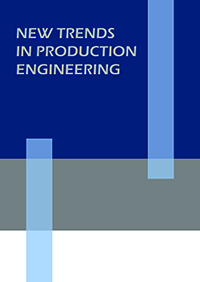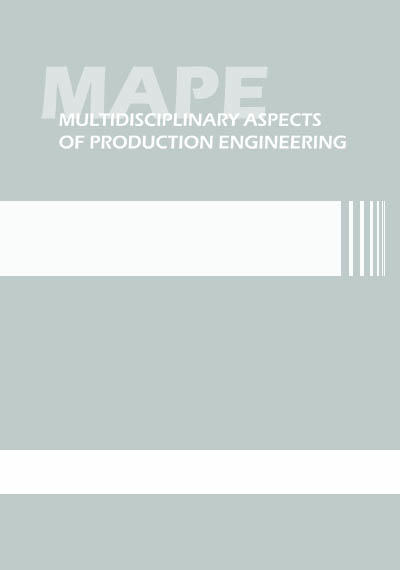For all parties involved in the act of publishing (the author, the book series editor(s), the peer reviewer and the publisher) it is necessary to agree upon standards of expected ethical behaviour. The ethics statements for the book series: New Trends in Production Engineering are based on the Committee on Publication Ethics (COPE).
EDITOR RESPONSIBILITIES
Accountability
The editor of a reviewed monograph is responsible for deciding which chapter submitted to the monograph should be published, and, moreover, is accountable for everything published in the book series. In making these decisions, the editor may be guided by the policies of the monograph’s editorial board as well as by legal requirements regarding libel, copyright infringement and plagiarism. The editor may confer with other editors or reviewers when making publication decisions. The editor should maintain the integrity of the academic record, preclude business needs from compromising intellectual and ethical standards, and always be willing to publish corrections, clarifications, retractions and apologies when needed.
Fairness
The editor should evaluate manuscripts for intellectual content without regard to race, gender, sexual orientation, religious belief, ethnic origin, citizenship, or political philosophy of the author(s). The editor will not disclose any information about a manuscript under consideration to anyone other than the author(s), reviewers and potential reviewers, and in some instances the editorial board members, as appropriate.
Confidentiality
The editor and any editorial staff must not disclose any information about a submitted manuscript to anyone other than the corresponding author, reviewers, potential reviewers, other editorial advisers, and the publisher, as appropriate.
Disclosure, conflicts of interest, and other issues
The editor will be guided by COPE’s Guidelines when considering retracting, issuing expressions of concern about, and issuing corrections pertaining to chapters that have been published in book series New Trends in Production Engineering.
Unpublished materials disclosed in a submitted manuscript must not be used in an editor’s own research without the express written consent of the author. Privileged information or ideas obtained through peer review must be kept confidential and not used for personal advantage.
The editor is committed to ensuring that advertising, reprint or other commercial revenue has no impact or influence on editorial decisions.
The editor should seek to ensure a fair and appropriate peer review process. Editors should recuse themselves (i.e. should ask a co-editor, associate editor or other member of the editorial board instead to review and consider) from considering manuscripts in which they have conflicts of interest resulting from competitive, collaborative, or other relationships or connections with any of the authors, companies, or (possibly) institutions connected to the chapters. Editors should require all contributors to disclose relevant competing interests and publish corrections if competing interests are revealed after publication. If needed, other appropriate action should be taken, such as the publication of a retraction or expression of concern.
Involvement and cooperation in investigations
Editors should guard the integrity of the published record by issuing corrections and retractions when needed and pursuing suspected or alleged research and publication misconduct. Editors should pursue reviewer and editorial misconduct. An editor should take reasonably responsive measures when ethical complaints have been presented concerning a submitted manuscript or published chapter.
REVIEWER RESPONSIBILITIES
Contribution to editorial decisions
Peer review assists the editor in making editorial decisions and, through the editorial communication with the author, may also assist the author in improving the manuscript.
Promptness
Any invited referee who feels unqualified to review the research reported in a manuscript or knows that its timely review will be impossible should immediately notify the editor so that alternative reviewers can be contacted.
Confidentiality
Any manuscripts received for review must be treated as confidential documents. They must not be shown to or discussed with others except if authorized by the editor.
Standards of objectivity
Reviews should be conducted objectively. Personal criticism of the author is unacceptable. Referees should express their views clearly with appropriate supporting arguments.
Acknowledgement of sources
Reviewers should identify relevant published work that has not been cited by the authors. Any statement that an observation, derivation, or argument had been previously reported should be accompanied by the relevant citation. A reviewer should also call to the editor's attention any substantial similarity or overlap between the manuscript under consideration and any other published data of which they have personal knowledge.
Disclosure and conflict of interest
Privileged information or ideas obtained through peer review must be kept confidential and not used for personal advantage. Reviewers should not consider evaluating manuscripts in which they have conflicts of interest resulting from competitive, collaborative, or other relationships or connections with any of the authors, companies, or institutions connected to the submission.
AUTHOR RESPONSIBILITIES
Reporting standards
Authors reporting results of original research should present an accurate account of the work performed as well as an objective discussion of its significance. Underlying data should be represented accurately in the manuscript. A chapter should contain sufficient detail and references to permit others to replicate the work. Fraudulent or knowingly inaccurate statements constitute unethical behaviour and are unacceptable.
Originality and Plagiarism
The authors should ensure that they have written entirely original works, and if the authors have used the work and/or words of others that this has been appropriately cited or quoted.
Multiple, redundant or concurrent publication
An author should not in general publish manuscripts describing essentially the same research in more than one monograph or primary publication. Parallel submission of the same manuscript to more than one monograph constitutes unethical publishing behaviour and is unacceptable.
Acknowledgement of sources
Proper acknowledgment of the work of others must always be given. Authors should also cite publications that have been influential in determining the nature of the reported work.
Authorship of a manuscript
Authorship should be limited to those who have made a significant contribution to the conception, design, execution, or interpretation of the reported study. All those who have made significant contributions should be listed as co-authors. Where there are others who have participated in certain substantive aspects of the research project, they should be named in an Acknowledgement section.
The corresponding author should ensure that all appropriate co-authors (according to the above definition) and no inappropriate co-authors are included in the author list of the manuscript, and that all co-authors have seen and approved the final version of the chapter and have agreed to its submission for publication.
Hazards and human or animal subjects
If the work involves chemicals, procedures or equipment that have any unusual hazards inherent in their use, the authors must clearly identify these in the manuscript.
Disclosure and conflicts of interest
All authors should disclose in their manuscript any financial or other substantive conflict of interest that might be construed to influence the results or their interpretation in the manuscript. All sources of financial support for the project should be disclosed.
Fundamental errors in published works
When an author discovers a significant error or inaccuracy in his/her own published work, it is the author’s obligation to promptly notify the monograph’s editor or publisher and cooperate with them to either retract the chapter or to publish an appropriate erratum.
PUBLISHER’S CONFIRMATION
In cases of alleged or proven scientific misconduct, fraudulent publication or plagiarism the publisher, in close collaboration with the editors, will take all appropriate measures to clarify the situation and to amend the chapter in question. This includes the prompt publication of an erratum or, in the most severe cases, the complete retraction of the affected work.
GENERAL INFORMATIONS
The publication language is English. All authors must take care of the language revision by they own. The language must be clear and accurate. The work should be written in an impersonal style. The editor reserves the right to send the manuscript to be reviewed. If English is a second language for the author, please consider having the manuscript proof read and edited before submitting.
AUTHORS’ INFO AND GUIDELINES
Abstract
The first page of the manuscript must begin with the title of the chapter, authors’ names and affiliations, and an abstract which should be in the interval of 100-300 words. For chapters reporting original research, abstract should state in brief the primary objective (the research questions addressed or any hypothesis tested), the research design, the methods and procedures employed, the number of subjects, the main results, and the conclusions drawn from these results (including their implications for further research, application or practice).
Authors’ full names/surnames should be provided. Indicate affiliations of the author(s). Below author’s name, author’s email should be indicated.
Key words:
Provide 3 to 5 key words or short phrases in alphabetical order.
The structure of the manuscript (recommended)
The body of the text of the monograph’s chapter must have the following parts:
- abstract and key words,
- introduction with a presentation of the problem of research and/or research focus, objectives (optional), and hypothesis (optional),
- methodology of research (stating general background of research, sample of research, instruments and procedures),
- results of research,
- discussion,
- conclusions,
- acknowledgements (if any),
- references,
- appendix (if any).
The structure of monograph’s chapter can be slightly different if the chapter is only theoretical qualitative research.
Chapter length
Regular chapter: 10-12 typewritten pages, including: title, author/s, abstract, real text, charts, drawings and literature/references;
Long chapter + 50 EURO: more than 12 typewritten pages, including: title, author/s, abstract, real text, charts, drawings and literature/references;
Font: Arial, size 11, heading 1 – capital letters, bold, interline 1.15
Page setup:
Size: A4, Portrait
Margins: Left 3.18, Right 2.54 cm, Top 2.54 cm, Bottom 2.54 cm, Header/Footer 1.5 cm.
Alignment: justify, line spacing single, paragraph before and after 0 pt, interline 1.15
Acronyms
Acronyms should be defined the first time they appear.
Tables and Figures
Tables and figures should be relevant, valuable, and visually attractive. Tables (made with Word or another programme) and figures must be referred to in the text and numbered in order of their appearance. Each table and figure should have a complete, descriptive title; and each table column an appropriate heading. The texts in tables and figures should be 11-point (in some cases 10) and their width should be 12 cm at maximum. The figures/graphics should be in form of .jpg (if not done with Word or Excel); resolution 300 dpi. Figures, tables (black and white colour, without ground-colour) and captions should be inserted within the manuscript at their appropriate locations. All graphics (figures) must be editable. The font size should be Times New Roman for all figures and tables. Figures should be carefully explained in the text and cited in numerical order. It is the author’s responsibility to obtain permission to reproduce illustrations, tables, etc. from other publications.
References
The Harvard citation style for writing references in the text and in the reference list must be used. The list of references should be presented after the text. The author should make sure that there is a strict one-to-one correspondence between the names and years in the text and those on the list. More information on Harvard citation style you can find here: https://www.mendeley.com/guides/harvard-citation-guide Manuscripts in which references are not in the Harvard citation style will be returned without review.
Language
The publication language is English. All authors must take care of the language revision by they own. The language must be clear and accurate. The work should be written in an impersonal style. The editor reserves the right to send the manuscript to be reviewed. If English is a second language for the author, please consider having the manuscript proof read and edited before submitting.
Note
All chapters must meet the criteria of originality and scientific quality. Obviously, they must also comply with style and format requirements. The chapter will not be subject to further review, if the manuscript is NOT WITHIN THE SCOPE OF THE BOOK SERIES NTPE and/or there is POOR USAGE OF LANGUAGE (all manuscripts must be written in clear and grammatical English).

New Trends in Production Engineering is covered by the following services:
- Baidu Scholar
- CNKI Scholar (China National Knowledge Infrastructure)
- CNPIEC - cnpLINKer
- EBSCO Discovery Service
- Google Scholar
- J-Gate
- KESLI-NDSL (Korean National Discovery for Science Leaders)
- MyScienceWork
- Naver Academic
- Naviga (Softweco)
- Primo Central (ExLibris)
- ReadCube
- Semantic Scholar
- Summon (ProQuest)
- TDNet
- WorldCat (OCLC)






